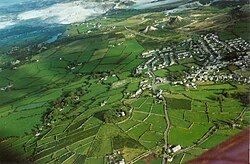St Dennis, Cornwall
| St Dennis | |
| Cornwall | |
|---|---|
 St Dennis from the air | |
| Location | |
| Grid reference: | SX951577 |
| Location: | 50°22’59"N, 4°52’59"W |
| Data | |
| Population: | 2,810 (2011) |
| Post town: | St Austell |
| Postcode: | PL26 |
| Dialling code: | 01726 |
| Local Government | |
| Council: | Cornwall |
| Parliamentary constituency: |
St Austell and Newquay |
St Dennis is a village in Cornwall, on the B3279 between Newquay and St Austell.
The parish had a population of 2,696 at the 2001 census. Of thiese, a quarter of the male population is employed in the extraction of china clay.
The village is famous for its church built on the site of an Iron age hillfort. Other major buildings include the Methodist chapel and the Boscawen Hotel.
History
St Dennis originated as several smaller settlements: Hendra, Trelavour and Whitepit. The area's population grew rapidly after William Cookworthy discovered China Clay in the area.[1]
Geography
The area is characterised by tips and pits of china clay mining but St Dennis village itself is designated an 'island settlement' which prevents encroachment by the china clay industry. Much of the parish is up to 500 feet above sea level, and the countryside is moorland with small fields enclosed by earth-covered granite walls known as 'hedges'. These hedges were constructed centuries ago, when the land was cleared for farming. Part of Trelavour Downs has been designated a Site of Special Scientific Interest and a Geological Conservation Review site. A small shallow pit of 0.7 acre was once worked for lithium and is the best known locality for biotite mica in Britain.
Churches and chapels

The church stands on top of a hill overlooking the village and has views over Goss Moor to the sea at Newquay. It is dedicated to St Denys and stands on the site of an Iron Age fort.
The tower is the oldest part of the church. The newer church was almost destroyed by fire in 1985.[2] Since the fire ,the church has risen again from the ashes. The new roof timbers were so large that they had to be lifted in by a Royal Navy Seaking helicopter.
The village also has a strong history of Methodism. At one stage there were three Methodist chapels in the village, but of these three, Carne Hill is the only chapel which is still open to this day.
Big Society
St Dennis Band is based in the village, and has a history of competing with some of the world's top bands. The Band recently gained Championship Status in 2009. Last year the band went to Blackpool, retaining their Championship status for another year.
The village has two public houses, The Commercial Inn and the Boscawen Hotel. There are also three clubs, the St Dennis Working Men's Club, the St Dennis Band Club, and the St Dennis Association Football Club.
Technology
The Land Master all-terrain vehicle was developed here in the late 1970s.
The Cornwall Energy Recovery Centre, a waste incinerator, has been built near St Dennis, despite opposition by the Parish Council and a case that went as far as the Supreme Court.[3][4]
Railway lines
The railway station for St Dennis is St Columb Road but there have been mineral railways in the parish, for which there was a St Dennis railway station.
Outside links
| ("Wikimedia Commons" has material about St Dennis, Cornwall) |
References
- ↑ Historic St Dennis - BBC, 21 January 2010
- ↑ St Denys Church fire damage, 1985
- ↑ CERC Updates 2009-2010 - Cornwall Council
- ↑ 'St Dennis incinerator campaigners vow to keep fighting': Cornish Guardian, 24 March 2014
